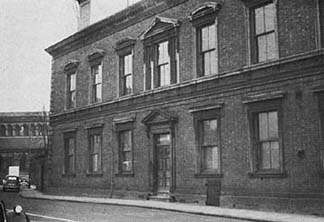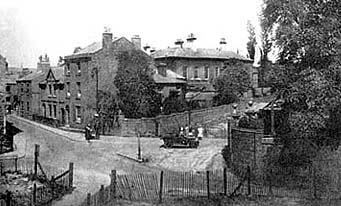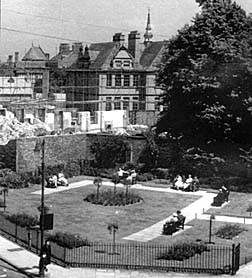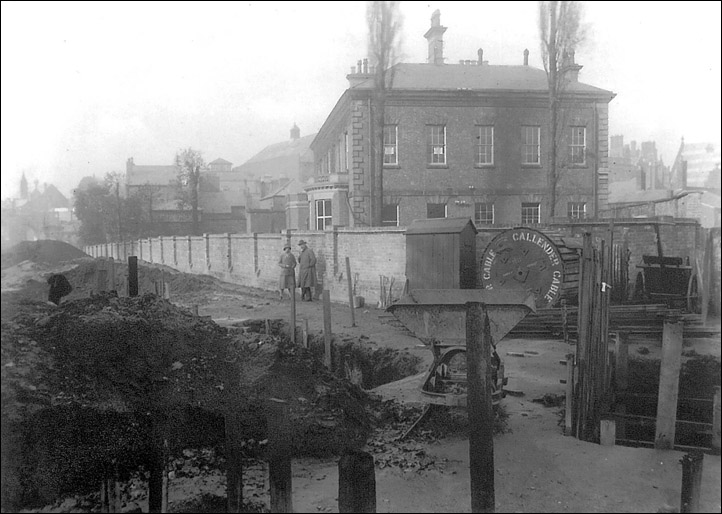
St. John's
House
was
a
large
18th
century
town
house
with
a
Georgian
neo-classical
facade
which
formerly
stood
on
the
north-east
portion
of
the
site
of
Chester's Roman
Amphitheatre.
Photographs
of
it
seem
to
indicate
that
it
retained
its
eighteenth
century
form
with
little
or
no
alteration
up
to
its
eventual
demolition
in
1958.
Left:
Front
of
St. John's
House
and
Little
St. John
Street
c 1950. St. John's
Church may
be
seen
in
the
background
Following
the
discovery
of
the
amphitheatre
in
1929,
ways
were
urgently
sought
to
raise
sufficient
money
to
fund
the
monument's
excavation.
The
Chester
Archaeological
Society
formed
a
Trust
and
astutely
purchased
St. John's
House
from
its
then
owners,
the
Anglo-American
Oil
Company.
From
May
1935,
they
leased
it
to
Cheshire
County
Council
for
successive
3
year
periods
and
invested
the
rents. The
County
Council's
legal
department
occupied
St.
John's
House
for
the
next
22
years,
but
relinquished
their
tenancy
in
1957,
when
the
new
County
Hall
next
to
the
river
near
the
Old
Dee
Bridge was
completed.
By
this
time,
the
income
generated
from
the
rent
of
St. John's
House
was
deemed
sufficient
to
allow
the
consideration
of
large-scale
excavation
of
the
northern
half
of
the
amphitheatre,
although
considerable
additional
funding
from
the
Ministry
of
Public
Works
was
also
necessary. The
house
was
duly
demolished
in
June
1958
and
excavation
of
the
amphitheatre
commenced
the
following
year
under
Mr.
Hugh
Thompson,
Curator
of
the
Grosvenor
Museum.
 During
the
course
of
demolition,
evidence
of
an
earlier
building
came
to
light,
in
the
form
of
a
stone
inscription
dated
1664.
This
house,
whose
plan
was
unfortunately
not
recorded,
was
probably
built
during
the
restoration
of
the
area
outside
the
Newgate
following
extensive
devastation
during
the
Civil
War.
During
the
course
of
demolition,
evidence
of
an
earlier
building
came
to
light,
in
the
form
of
a
stone
inscription
dated
1664.
This
house,
whose
plan
was
unfortunately
not
recorded,
was
probably
built
during
the
restoration
of
the
area
outside
the
Newgate
following
extensive
devastation
during
the
Civil
War.
Right: a rear view of St. John's House just before its demolition in 1958. A corner of Dee House may just be seen on the far left
In
1892,
the
Rev
Scott,
incumbent
and
historian
of
St. John's
Church,
reproduced
a
plan
of
the
church, "taken
from
two
plans
of
1589
in
the
British
Museum" which
showed
an
even
earlier
building
on
the
site,
'Mr
Marbury's
house',
which
may
have
been
in
existence
as
early
as
1470
but
was
presumably
destroyed
during
the
siege,
when
the
neighbouring
St. John's
churchyard
was
occupied
by
Parliamentary
troops
who
set
up
a
gun
battery
there
on
20th
September
1644.`
The
occupants
of
St. John's
House
over
the
years
were
many
and
various.
It
is
first
mentioned
in
the
will
of
former
Mayor,
City
Recorder
and
Alderman, James
Comberbach,
builder
of neighbouring
Dee
House,
being
referred
to
there
as "newly
erected".
James
Slaughter
Esq took
the
lease
in
1751
and
passed
it
on
to
his
daughter Elizabeth in
1789.
In
1811,
documents
refer
to
Indentures
of
lease
and
release
between
this
Elizabeth
and George
Brook, "a
Shropshire
gentleman".
This
dealt
with
"All
that
capital messuage (dwelling
house)
with
coach
house,
stables,
garden,
orchard,
court
yard
etc...
and
all
that
cottage
in
the
garden
theretofore
occupied
by
the
widow
Roden
lately
deceased,
all
which
except
the
cottage,
were
in
the
occupation
of
John
Nicolls
and
his
undertenants".
George
Brook
remained
until
1840
but
the
Census
of
the
following
year
names Mrs
Hannah
Brook as
the
occupant,
who
is
described
as
'independent'
with
three
children
and
eleven
servants.
Two
years
later,
however,
in
1842,
George
Brook,
then
described
as "late
of
Chester" is
party
to
an
Indenture
to
convey
St. John's
House
to Dr
James  Edwards.
The
money
was
out
up
by
his
father-in-law, Robert
Main,
who,
in
1844,
sold
the
property
to Thomas
Reed.
Dr
Edwards
and
his
wife
were,
however,
permitted
to
remain
in
occupancy
during
their
joint
lives.
It
was
then
briefly
occupied
by
a Miss
Giles and Miss
Kerr.
Edwards.
The
money
was
out
up
by
his
father-in-law, Robert
Main,
who,
in
1844,
sold
the
property
to Thomas
Reed.
Dr
Edwards
and
his
wife
were,
however,
permitted
to
remain
in
occupancy
during
their
joint
lives.
It
was
then
briefly
occupied
by
a Miss
Giles and Miss
Kerr.
Left: St. John's
House
is
in
the
centre
background
of
this
photograph,
taken
from
the
top
of
the
Newgate
and
showing
the
mass
of
buildings
that
once
covered
the
site.
In
the
foreground
you
can
see
the
lining
walls
which
were
all
that
was
ever
built
of
the
city
corporation's
ill-conceived
road
scheme
In
1855,
the
house
was
occupied
by
John
J
Brez,
an
accountant
with
offices
in
Eastgate
street,
in
which
he
had
formerly
resided,
but
the
same
year
it
was
sold
to
Meadows
Frost,
resident
of
Richmond
Bank,
for
the
sum
of
£2020.
Described
as
a
merchant
in
1864
and
by
1871
as
a
Justice
of
the
Peace,
Meadows
Frost
stayed
in
the
house
until
1881
when
he
retired
from
business
and
moved
to
Hope,
Flintshire,
where
he
died
two
years
later.
This
marks
the
end
of
St. John's
House's
service
as
a
private
family
residence.
 According
to
a
book
published
by
the
Convent
at
Dee
House
to
celebrate
its
Golden
Jubilee
in
1975,
St. John's
House
was
purchased
by
them
in
1886
and
the
wall
separating
the
properties
taken
down.
However,
it
long
continued
to
house
a
wide
range
of
occupants
so
it
is
unclear
if
the
Convent
disposed
of
the
house
and
its
reduced
gardens
or
if
the
purchase
had
merely
been
of
part
of
these
gardens.
According
to
a
book
published
by
the
Convent
at
Dee
House
to
celebrate
its
Golden
Jubilee
in
1975,
St. John's
House
was
purchased
by
them
in
1886
and
the
wall
separating
the
properties
taken
down.
However,
it
long
continued
to
house
a
wide
range
of
occupants
so
it
is
unclear
if
the
Convent
disposed
of
the
house
and
its
reduced
gardens
or
if
the
purchase
had
merely
been
of
part
of
these
gardens.
Right: A view from July 1958 of the gardens which for a while covered part of the amphitheatre site. Behind may be seen the Grosvenor St.John's School, now the Chester Visitor Centre, and the remains of St. John's House, then being demolished by the Chester Archaeological Society to commence their excavation. The gardens, another view of which may be seen here- were to follow soon afterwards.
In
1892,
the
house
was
acquired
by
the
Chester
Conservative
Club and
then
its
history
throughout
the
early
20th
century
was
of
subdivision
between
a
variety
of
businesses.
In
1902, Hugh
Miller
and Co., costumiers,
were
established
here
and
by
1910, C E
Luggard
and
Co.,
electrical
engineers
had
an
office
which
they
occupied
until
after
1919.
Also in 1910, a photographer, J H Hammond, traded here but by 1914 had been replaced by the YMCA and Richard Dahl, a language teacher.
In
1919,
they
were
joined
by R W
Roberts,
milinery
agent
but
by
1923
the
two
businesses
in
occupancy
were
the Anglo-American
Oil
Company and
the Navy,
Army
and
Air
Force
Institutes; by
1928
they
had
been
joined
by George
Lenthall & Sons,
milliners.
In
1933,
the
latter,
together
with Callander's
Cable & Construction
Co
Ltd and K C
Edwards,
accountants,
were
the
tenants
and
the
following
year
the
house
was
purchased
for £4000
by
the Chester
Archaeological
Society,
who,
as
recorded
above,
leased
it
to Cheshire
County
Council for
the
next
twenty
two
years
and
then,
in
July
1958,
finally
demolished
it
to
allow
the
excavation
of
the
amphitheatre
to
commence.
A
correspondent
in
the
local
press
in
August
2000
reminisced
about
St. John's
House,
saying
the
entrance hall,
which
was
on
the
north
side
(top
photograph),
had
attractive
floor
tiles
and
outside,
on
the
east,
was
a
huge
well.
There
were
some
fine
trees
and,
during
the
war
years,
when
air
raid
shelters
for
St. John's
school
were
dug,
a
NAAFI
canteen
adjoined
the
Georgian
mansion.
Learn more about St. John's House- and much more of the fascinating story of the Chester Amphitheatre here
